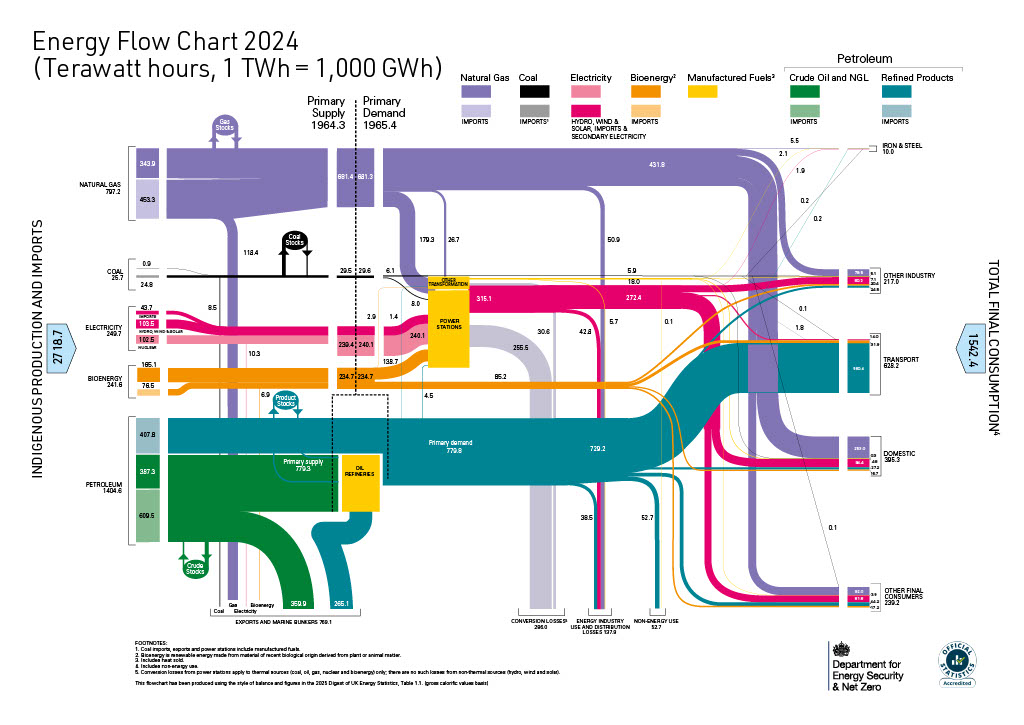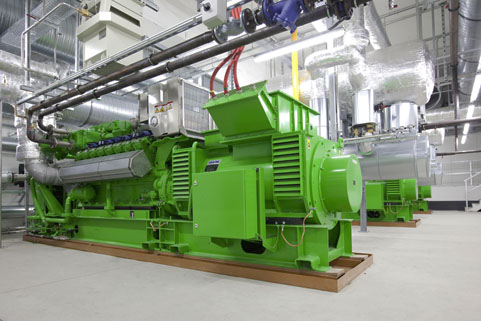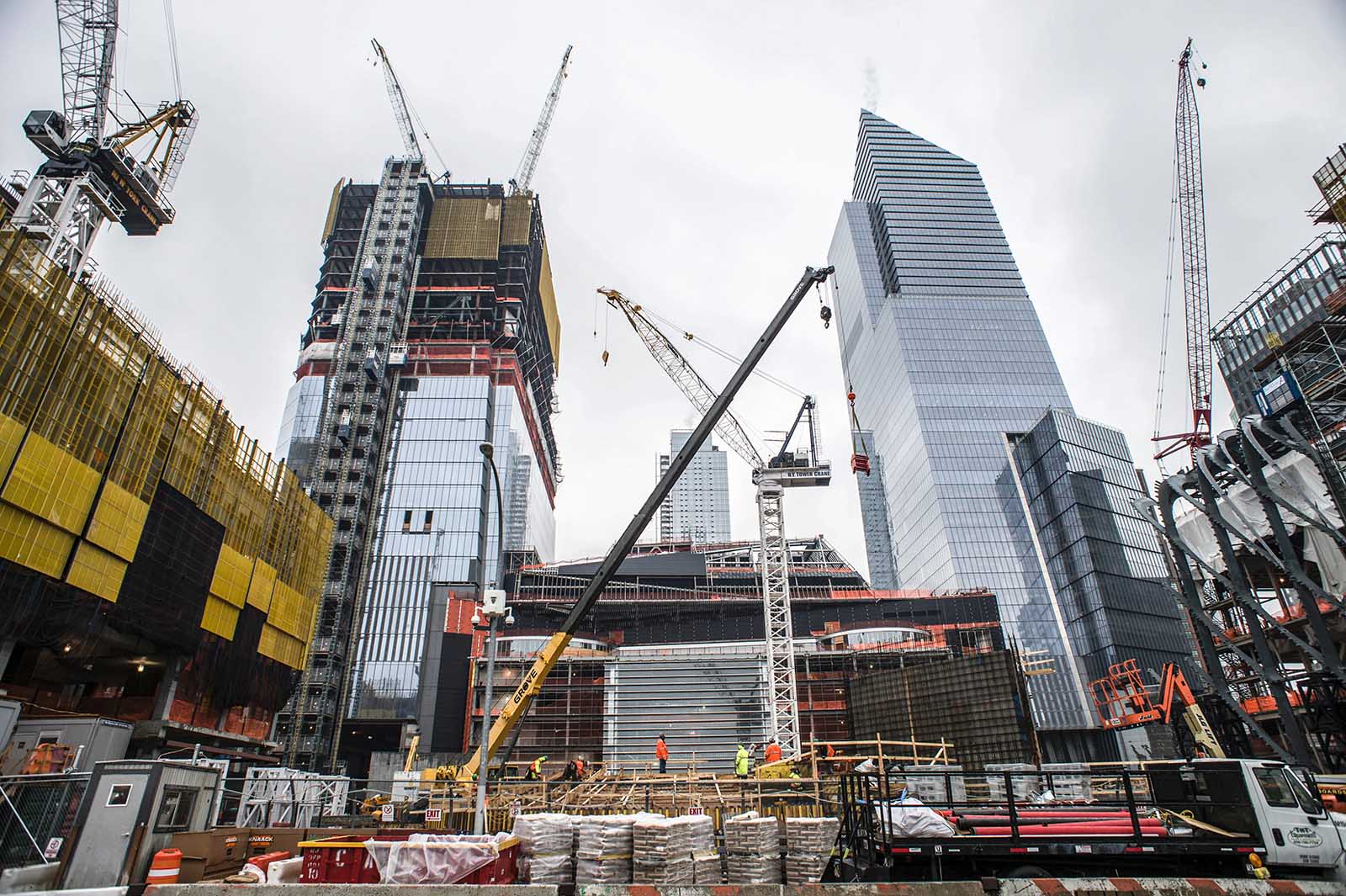 UK Energy Security Through Distributed Combined Heat and Power
UK Energy Security Through Distributed Combined Heat and Power
A Policy Paper for Resilient, Efficient Energy Infrastructure
Executive Summary
The April 2025 Iberian Peninsula blackout demonstrated that increasing grid complexity—driven by high renewable penetration and distributed generation—creates systemic vulnerabilities that threaten energy security. This paper proposes a fundamental paradigm shift in UK energy policy: repositioning Combined Heat and Power (CHP) and tri-generation systems as primary energy infrastructure for critical and commercial facilities, with the electricity grid serving as a balancing and coordination network rather than the sole supply backbone.
This approach simultaneously addresses energy security, system resilience, efficiency, and decarbonization objectives while reducing—rather than increasing—grid coordination complexity.
1. The Problem: Grid Complexity as Systemic Risk
1.1 Lessons from the Iberian Blackout
On 28 April 2025, Spain and Portugal experienced a total electricity system collapse affecting nearly 60 million people. Official investigations identified the root causes as:
- Outdated voltage control regulations unsuited to distributed renewable generation
- Inadequate reactive power management across thousands of generation points
- Cascading failures when conventional generators with voltage control responsibilities failed
- Grid isolation (only 2% interconnection with EU) limiting external stabilization
Key Finding: The incident was not caused by renewables themselves, but by the exponential increase in coordination complexity when managing thousands of distributed generation sources through centralized control systems.
1.2 Implications for UK Grid Architecture
The UK faces similar challenges:
- Rapid expansion of distributed solar and wind generation
- Ambitious Clean Power 2030 targets requiring unprecedented renewable integration
- 14 regional Distribution Network Operators coordinating increasingly complex power flows
- Growing electrification of transport and heating increasing demand volatility
- Critical infrastructure entirely dependent on grid reliability
The fundamental vulnerability: Any architecture dependent on perfect real-time coordination of thousands of inputs across a complex network contains inherent fragility. No amount of investment in "smart grid" technology eliminates this systemic risk.
 2. The Proposed Solution: CHP-Primary Architecture
2. The Proposed Solution: CHP-Primary Architecture
2.1 Inverting the Energy Hierarchy
Current Model:
- Grid = primary supply
- On-site generation = emergency backup only
- Buildings = passive consumers
Proposed Model:
- CHP/Tri-generation = primary supply
- Grid = balancing, backup, and export market
- Buildings = active energy hubs providing grid stability
2.2 Why CHP Reduces System Complexity
Unlike inverter-based renewables that require sophisticated phase-locked loop tracking and voltage management:
- CHP units provide inherent inertia through rotating machinery
- Natural voltage and frequency stability without complex control systems
- Dispatchable response to grid signals
- Fewer coordination points: Hundreds of stable CHP units vs. millions of solar inverters
- Local voltage control reducing transmission-level management burden
CHP provides the "solid baseload generator to control voltage and frequency" that complex renewable-heavy grids lack.
3. The Technical Case for Distributed CHP
3.1 Energy Efficiency
Grid electricity pathway:
- Central generation: 35-40% efficiency
- Transmission losses: 5-8%
- Net delivered efficiency: ~33%
CHP pathway:
- Combined heat and power: 80-90% total efficiency
- Minimal transmission (generated at point of use)
- Net delivered efficiency: 80-90%
Tri-generation (CHP + absorption cooling):
- Year-round utilization of thermal energy
- Summer cooling from waste heat
- 85-95% total efficiency achievable
3.2 Grid Resilience Through Decentralization
Distributed CHP architecture creates:
- Multiple independent generation sources: Single failures cannot cascade
- Local islanding capability: Facilities maintain operation during grid outages
- Reduced transmission stress: 40-60% of demand met locally
- Geographic diversity: Generation distributed across entire network
- Simplified coordination: Fewer, more predictable generation points
3.3 Energy Security
Critical infrastructure with CHP achieves:
- True energy independence from grid failures
- Continuous operation capability (not just emergency backup)
- Seamless transition during outages (already running)
- Indefinite operation with fuel supply maintained
- Dual fuel infrastructure: Both gas and electricity available
4. Implementation Framework
4.1 Four-Tier Deployment Strategy
 Tier 1: Critical Infrastructure (Mandatory CHP/Tri-gen)
Tier 1: Critical Infrastructure (Mandatory CHP/Tri-gen)
Facilities:
- NHS hospitals and healthcare facilities
- Emergency services (fire, police, ambulance)
- Data centers and telecommunications
- Water and wastewater treatment plants
- Food production, storage, and cold chain logistics
- Major transport hubs
Capacity Target: 5-10% of UK electricity demand
Timeline: 100% compliance by 2030
Requirement: CHP as primary power, grid as backup
Tier 2: Commercial and Industrial (Incentivized CHP/Tri-gen)
Facilities:
- Large office districts and business parks
- Shopping centers and retail complexes
- Manufacturing facilities with thermal demand
- Universities and educational campuses
- Hotels and leisure facilities
- Food processing and brewing
Capacity Target: 20-30% of UK electricity demand
Timeline: 50% adoption by 2035
Requirement: Economic incentives, streamlined planning
Tier 3: District Energy Systems
Applications:
- Urban neighborhoods with shared infrastructure
- New residential and commercial developments
- Social housing estates
- Regeneration projects
Capacity Target: 15-25% of UK electricity demand
Timeline: All major new developments by 2030
Requirement: Mandatory assessment, planning priority
Tier 4: Residential and Small Commercial
Approach:
- Grid-connected (now simplified, lower capacity grid)
- Rooftop solar with battery storage for self-consumption
- Heat pumps or district heating connections
- Flexible demand response
Capacity: Remaining 40-60% of demand
Character: Lower criticality, flexible loads
4.2 Regulatory Framework
Redefining "Primary" and "Backup" Power
- Amend Building Regulations to classify CHP as primary infrastructure
- Revise grid connection requirements for critical facilities
- Update emergency planning guidance to reflect on-site generation
- Modify insurance and liability frameworks accordingly
Planning and Permitting Reform
- Statutory 8-week approval for CHP at Tier 1 facilities
- Presumption in favor for Tier 2 applications
- Remove CHP from environmental impact assessment for bio-methane systems
- Exempt CHP modernization from lengthy planning processes
Grid Code Modifications
- Mandate CHP units >500kW to provide grid stability services
- Require frequency response capability (already inherent in design)
- Establish technical standards for grid synchronization
- Create CHP dispatch protocols for system stress periods
4.3 Economic Incentives
Capital Support
- Tier 1: 50% capital grants for CHP/tri-gen installation
- Tier 2: 30% capital grants plus accelerated depreciation
- Tier 3: Enhanced Renewable Heat Incentive for district systems
- Technology: Additional 20% for hydrogen-ready equipment
Operational Incentives
- Export tariffs: Premium payments for grid stability services (£80-120/MWh)
- Capacity market: Guaranteed payments for dispatchable CHP capacity
- Carbon contracts: 15-year price support for bio-methane CHP
- Business rates: 50% reduction for facilities with CHP
Fuel Support
- Bio-methane production: £40/MWh support for agricultural/waste feedstocks
- Green gas certification: Tradeable certificates for bio-methane
- Hydrogen transition: Support for dual-fuel conversion equipment
- Strategic reserve: Subsidized on-site fuel storage for critical facilities
5. Fuel Strategy and Decarbonization Pathway
5.1 Natural Gas to Bio-methane Transition
Phase 1 (2025-2030): Natural Gas Foundation
- Deploy CHP using existing gas infrastructure
- Establish operational frameworks and technical standards
- Build installer capacity and supply chains
Phase 2 (2030-2040): Bio-methane Scale-up
- Target: 50% bio-methane blend in CHP fuel
- Expand anaerobic digestion capacity (agricultural waste, food waste, sewage)
- Develop biomass gasification for forestry and organic waste
- Create green gas grid injection infrastructure
Phase 3 (2040-2050): Hydrogen Integration
- Hydrogen-ready equipment deployed from 2030 onwards
- Progressive hydrogen blending (20% → 100%)
- Alignment with UK Hydrogen Strategy
- CHP units provide flexibility during hydrogen rollout
5.2 UK Bio-methane Potential
Feedstock availability:
- Agricultural waste: 15-20 TWh/year
- Food waste: 10-15 TWh/year
- Sewage sludge: 5-8 TWh/year
- Forestry residues: 8-12 TWh/year
- Total potential: 38-55 TWh/year
CHP demand (Tiers 1-3):
- Approximately 100-150 TWh electrical output
- Gas input required: ~200-300 TWh (at 50% electrical efficiency)
- Bio-methane could supply 15-25% of CHP fuel demand
- Remainder: natural gas transitioning to hydrogen
5.3 Carbon Impact
Current grid electricity (2025):
- ~200g CO₂/kWh (declining with renewables)
Natural gas CHP:
- ~250g CO₂/kWh electrical output (but with waste heat utilization)
- Net carbon per unit total energy: ~180g CO₂/kWh equivalent
Bio-methane CHP:
- Carbon neutral or negative (depending on feedstock and methane capture)
- 80-100% reduction vs. fossil gas
Long-term (hydrogen CHP):
- Zero carbon at point of use
- Full decarbonization achievable by 2050
6. Economic Analysis
6.1 Infrastructure Investment Requirements
Tier 1 (Critical Infrastructure):
- ~15 GW CHP capacity required
- Capital cost: £30-40 billion over 5 years
- With 50% grants: £15-20 billion public investment
Tier 2 (Commercial/Industrial):
- ~40 GW CHP capacity
- Capital cost: £80-100 billion over 10 years
- With 30% grants: £24-30 billion public investment
Tier 3 (District Energy):
- ~25 GW CHP capacity
- Capital cost: £50-65 billion over 10 years
- Mixed public/private funding
Total public investment: £39-50 billion over 10 years
6.2 Comparison with Alternative Grid Investment
Current Clean Power 2030 transmission plan:
- £100+ billion for transmission network upgrades
- £50+ billion for distribution network reinforcement
- Ongoing complexity and operational costs
- Total: £150+ billion
CHP-Primary approach:
- £39-50 billion CHP deployment
- £30-40 billion reduced transmission investment (lower capacity requirements)
- Reduced distribution reinforcement needs
- Total: £69-90 billion
Net saving: £60-80 billion over 10 years
6.3 Operational Economics
Benefits:
- Reduced transmission losses: £1-2 billion/year saved
- Higher system efficiency: £3-5 billion/year fuel savings
- Grid stability services: £1-2 billion/year avoided balancing costs
- Resilience value: Avoided blackout costs (Spain: estimated €10+ billion)
Costs:
- Higher maintenance for distributed assets
- Fuel costs (offset by efficiency gains)
- Training and workforce development
Net operational benefit: £4-8 billion/year by 2035
7. Strategic Benefits for UK
7.1 Energy Security
- Critical services maintain operation during grid failures
- Reduced dependence on electricity imports
- Fuel diversity (gas, bio-methane, hydrogen pathways)
- Strategic fuel storage feasible at facility level
7.2 Industrial Strategy
- Major domestic deployment opportunity (£200+ billion market)
- UK manufacturing capability for CHP equipment
- Installation and maintenance jobs across all regions
- Export potential for integrated energy solutions
7.3 Grid Simplification
- Transmission network handles bulk transfers only
- Distribution becomes coordination platform, not supply network
- Fewer real-time coordination points
- More stable, predictable system operation
7.4 Decarbonization Flexibility
- Clear pathway: natural gas → bio-methane → hydrogen
- Utilizes existing infrastructure progressively
- Technology-neutral (fuel can evolve)
- Avoids stranded assets (hydrogen-ready from 2030)
7.5 Social Equity
- District energy systems benefit social housing
- Reduced transmission costs lower bills
- Job creation in all regions (installation, maintenance)
- Energy security for vulnerable communities
8. Addressing Counterarguments
8.1 "CHP Uses Fossil Fuels"
Response: CHP is a pathway, not an endpoint. Natural gas provides immediate deployment using existing infrastructure while bio-methane and hydrogen scale up. The architecture remains valid regardless of fuel source. Total lifecycle emissions are lower than current grid electricity when thermal utilization is considered.
8.2 "Distributed Generation Is More Expensive"
Response: When full system costs are considered (transmission, distribution, balancing, resilience), distributed CHP is cost-competitive or cheaper. Avoided transmission investment alone justifies significant CHP deployment. Operational efficiency gains (80-90% vs. 33%) provide ongoing economic benefits.
8.3 "We Need Renewables for Decarbonization"
Response: This proposal does not oppose renewables—it contains their complexity within a more stable architecture. Renewables continue to grow in Tier 4 (residential/small commercial) where intermittency is manageable. CHP provides the stable foundation that enables higher renewable penetration safely.
8.4 "CHP Doesn't Work Without Heat Demand"
Response: Tri-generation solves this through absorption cooling. UK has year-round heat demand (winter) and cooling demand (summer, data centers). Proper facility selection ensures high utilization factors. District energy systems aggregate demand for better economics.
8.5 "This Is Too Disruptive"
Response: The alternative—retrofitting ever more complex coordination onto a grid designed for centralized generation—is more disruptive and ultimately futile. The Spain blackout demonstrates the limits of that approach. Implementing CHP-primary over 10-15 years is evolutionary, not revolutionary.
9. Implementation Roadmap
Phase 1 (2025-2027): Foundation
- Establish regulatory framework and technical standards
- Launch Tier 1 capital grant program
- Pilot district energy systems in 10 locations
- Expand bio-methane production capacity
- Training programs for installers and operators
Phase 2 (2028-2030): Acceleration
- Mandatory CHP for new critical infrastructure
- Scale Tier 2 incentives
- 50 GW CHP capacity deployed
- Bio-methane blend reaches 20%
- Grid code updates for CHP coordination
Phase 3 (2031-2035): Consolidation
- 80% Tier 1 compliance achieved
- 40% Tier 2 adoption
- Major district energy systems operational
- Bio-methane blend reaches 40%
- Hydrogen blending begins
Phase 4 (2036-2050): Maturity
- 100 GW+ CHP capacity operational
- Grid role fully transitioned to balancing/coordination
- Bio-methane/hydrogen dominate CHP fuel mix
- Full decarbonization pathway clear
- Model exported to other nations
10. Policy Recommendations
Immediate Actions (2025-2026)
- Establish "CHP-First" Task Force within Department for Energy Security and Net Zero
- Allocate £5 billion initial capital grants for Tier 1 facilities
- Mandate CHP assessment for all planning applications >1 MW thermal demand
- Launch pilot programs at 20 NHS hospitals and 10 data centers
- Commission detailed bio-methane potential study and production roadmap
- Update Building Regulations to reclassify CHP as primary infrastructure
Regulatory Reform (2026-2027)
- Revise grid codes to recognize CHP as stability provider
- Streamline planning for CHP installations (8-week determination)
- Create enhanced export tariffs for CHP (£80-120/MWh)
- Establish hydrogen-ready equipment standards
- Mandate Tier 1 CHP for critical infrastructure by 2030
Economic Framework (2027-2028)
- Launch £20 billion CHP deployment fund (10-year program)
- Create bio-methane carbon contracts (15-year terms)
- Introduce business rates relief for CHP facilities
- Establish CHP capacity market with guaranteed revenues
- Fund skills development (10,000 installers by 2030)
Strategic Development (2028-2035)
- Scale bio-methane production to 20 TWh/year
- Deploy district energy systems in 100+ locations
- Achieve 80 GW CHP capacity operational
- Reduce transmission investment by £40 billion vs. baseline
- Demonstrate 30% reduction in system complexity metrics
11. Conclusion: Engineering Pragmatism Over Ideology
The April 2025 Iberian blackout provides an unambiguous lesson: complexity is the enemy of reliability. As grids integrate more distributed, intermittent generation sources, the coordination challenge grows exponentially. No amount of "smart grid" investment eliminates the fundamental fragility of systems dependent on perfect real-time synchronization of millions of inputs.
The CHP-primary architecture proposed in this paper represents engineering pragmatism:
- Generate energy where it's needed, minimizing transmission complexity
- Use fuel that can be stored and transported, providing inherent flexibility
- Provide inherent stability through rotating machinery and thermal inertia
- Achieve maximum efficiency through combined heat and power utilization
- Decarbonize the fuel, not the architecture—maintaining flexibility for bio-methane and hydrogen
This is not a rejection of renewables or decarbonization—it is a recognition that the path to a zero-carbon energy system must maintain reliability and resilience. Distributed CHP provides the stable foundation that enables safe integration of variable renewables at the grid edge.
The UK has an opportunity to lead the world in demonstrating that energy security, efficiency, and decarbonization are compatible objectives. The technology is mature. The infrastructure exists. The economics are favorable.
What is required is the political courage to acknowledge that the current paradigm—ever-increasing grid complexity managed through ever-more-sophisticated control systems—has fundamental limits that recent events have exposed.
The choice is clear: Continue down a path of increasing fragility, or embrace a distributed architecture that reduces complexity while improving efficiency, resilience, and security.
This paper recommends the latter.
Appendices
Appendix A: Technical Specifications for CHP Systems
Appendix B: Bio-methane Feedstock Availability by Region
Appendix C: Economic Modeling Assumptions and Sensitivity Analysis
Appendix D: International Case Studies (Denmark, Netherlands, Germany)
Appendix E: Grid Stability Metrics and Monitoring Framework
Appendix F: Legal and Regulatory Analysis
Appendix G: Stakeholder Consultation Summary
Document prepared by: [Policy working group]
Date: October 2025
Version: 1.0 for consultation
Contact: [Department for Energy Security and Net Zero]
This policy paper reflects analysis following the April 2025 Iberian Peninsula blackout and represents a fundamental reassessment of energy infrastructure priorities in light of demonstrated systemic vulnerabilities in complex, renewable-heavy electricity grids.
